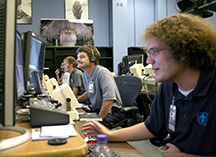
During each of the three space shuttle flights since the Columbia disaster, the Sandia Laser Dynamic Range Imager (LDRI) sensor has been used to help ensure that the shuttle’s thermal protection system is intact before the spacecraft returns to earth.
During the latest Atlantis mission nearly two dozen Sandians served as the ground station team at NASA’s Johnson Space Center near Houston, Texas.
During the flight while preparing for reentry, astronauts saw several unidentified objects floating in space nearby. Mission control decided to do a quick inspection of the shuttle’s skin using NASA’s in-house video camera.
“In the spirit of doing everything possible to aid the NASA screeners, the Sandia ground station team processed the NASA data and provided them with improved, high-quality imagery that helped NASA make the decision to return the shuttle to earth,” says team member Mark Heying (2624).
On flight day two after liftoff, the LDRI sensor is used in a series of multiple pass scans of the leading edges of both wings of the shuttle and of the nose cap. Approximately three hours of video is acquired. The operation is repeated just before the shuttle returns to earth, in case the shuttle was impacted by micrometeorites or space debris while on orbit. The sensor generates images of 720 by 480 pixels, at 30 Hz, which are transmitted to the Space Center.
The Sandia team staffed four workstations, which captured the down-linked data and provided various types of products for the NASA screening teams. The first product, called level 1, is the imagery corrected for transmission line artifacts incurred, and for fixed pattern noise, which is called flat field correction.
When the level 1 images are delivered to NASA, the total number of frames is reduced by a factor of four, Mark says. This is to help the screeners avoid information overload, while ensuring that full inspection coverage is maintained.
Another ground station product is generated by registering multiple contiguous frames together into a single sharpened image. This high-quality, low-noise imagery is closely examined by NASA screeners for artifacts that did not exist on the shuttle before lift off. If any potential defects are found, an “area of interest” is declared and a request goes out to the Sandia team for a detailed report.
By using a set of in-house processing tools, workstation operators can quickly generate a report that details the length, width, and depth of the specified object, says Mark. The team can also generate a 3-D point cloud image, which can be rotated and examined from numerous angles and zoom settings.
Since the first return-to-flight mission the Sandia team has applied multiple lessons learned to improve the quality of the imagery products and the speed at which they are delivered.
“We have also created several tools to aid NASA that go above and beyond the original requirements,” says Mark. “These tools include real-time documentation of acquisition events, and web-based graphical representation of scan coverage.”
New next-generation software is in the works to improve the operator interface, and to speed the delivery of processed imagery even further.
“This mission was another example of the dedication and willingness of the Sandia team to do everything possible to help NASA complete the construction of the International Space Station in a timely and safe manner,” says Mark.